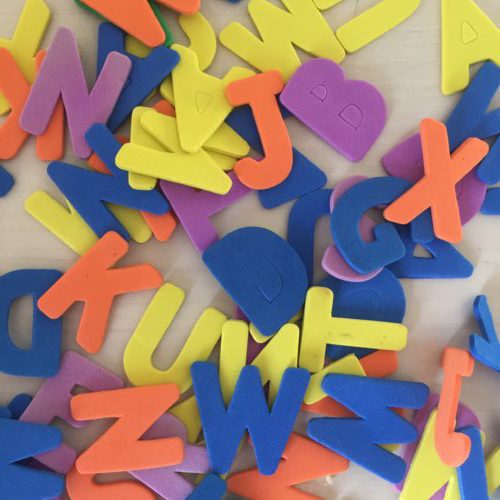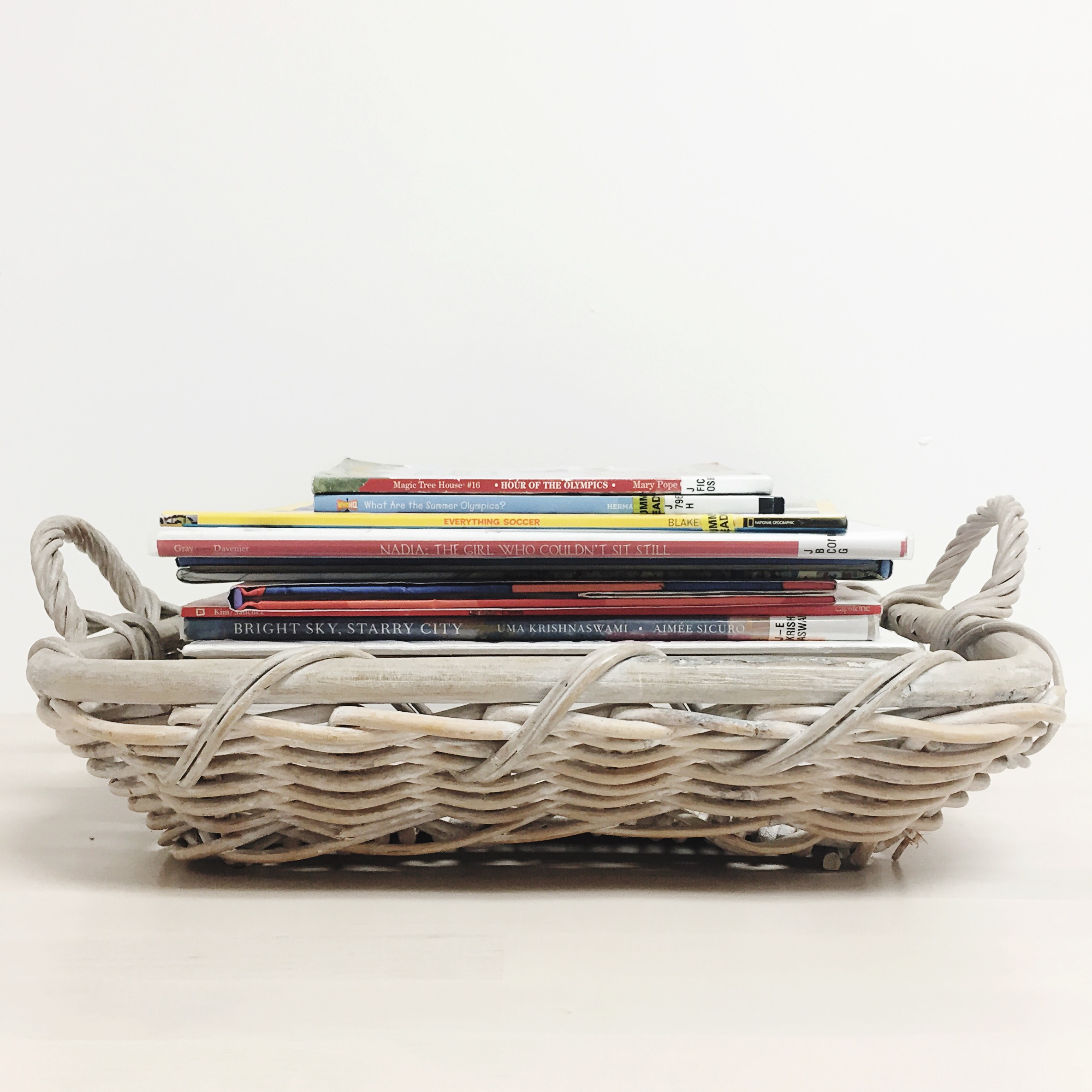The alphabet is one of those hallmarks of the preschool years. Just about every kid dances into Kindergarten confidently able to sing their ABCs and recognize at least some letters.
How does that happen? Does it require constant drilling and flashcards? Or will kids arrive at this knowledge in a more natural way?
I homeschooled my twins through preschool and worked with preschoolers for 10 years before that and I can assure you that no flashcards are required. Over the years I became confident in three things:
- Children love to learn and if you pay attention they will tell you when they grow curious about letters (and anything else).
- Alphabet books and natural literacy activities are a lot more fun, motivating, and helpful in the long term than drilling letters.
- Every child learns at their own pace.
When my twins turned four one of them knew all of their letters, the sounds they make and was starting to put together how letters make words. The other child (their twin) knew the letters in their name, that Mama starts with M and Daddy starts with D.
Obviously, despite being in the same house, with the same teacher (me), and experiencing most of the same things they learned letters at a different pace. This is normal.
Kids learn to walk at their own pace, they also learn to read at their own pace. Do not stress about this! Believe me I know how incredibly hard this is, especially when you have other kids to compare them too, but don’t. I remind myself daily that there is a huge range of normal where all learning objectives are concerned.
When your preschooler is interested, here are my favorite Alphabet picture books and natural literacy activities.
this post includes affiliate links.
10 Best Alphabet Books to Read Aloud

1. Alphabet Under Construction by Denise Fleming
This is a favorite on our shelves. The little mouse has a plan to make all the letters. He glues the G, nails the N and so on. This book makes you want to get crafty and especially appeals to my construction loving son. 2+

2. Chicka Chicka Boom Boom by Bill Martin Jr.
This is a classic and one of the first alphabet books young children read. It’s rhymic language and playful illustrations are irresistible to young ears. There is a shortened board book version to this one that makes a perfect introduction to the alphabet. 1+
(find it online)

3. Kipper’s A to Z: An Alphabet Adventure by Mick Inkpen
A fun alphabet adventure where lovable Kipper and his friends search for something for each letter. Sweet illustrations, clever vocabulary, and fun way to inspire your own alphabet adventure. 2+
find it online

4. 1 2 3 versus A B C by Mike Boldt
Which is more important? Letters or Numbers? My twins thought this one was laugh out loud silly. Funny characters, playful illustrations, and imaginative competiton between two things we use every day. 3+
Find it Online

5. Z is for Moose by Kelly Bingham
Silly alphabet book about a moose who is super excited for his page to arrive only to find a Mouse on the M page. Can Zebra figure out how to get his friend into the book? This is one of our favorite read alouds period. 3+
Find it Online

6. Anno’s Alphabet by Mitsumasa Anno
Simply illustrated book by one of my absolute favorite author/illustrators. Anno’s Counting House is my favorite, but this is also a fun and unique alphabet book. 3+
7. An Annoying ABC by Barbara Bottner
“It was a quiet morning until Adelaide annoyed Bailey. Bailey blamed Clyde. Clyde cried…” So begins this alphabetic tale of a busy morning in a colorfully named classroom. 3+
Find it Online

8. M is for Magnolia: A Mississippi Alphabet Book Michael Shoulders
If you search you can find an alphabet book for each state. My kids own one for each state they have lived in (Minnesota, Wisconsin, and Mississippi so far). Being the avid travelers we are, this is a fun way to get to know your state or the one you are visiting a little better. 3+
Find it Online

9. Take AWAY the A by Michael Escoffier
“Without the A the BEAST is BEST” begins this fun alphabet book. A clever look at letters and how their presence changes a word. Humorously illustrated by Kris Di Giacomo, this is a picture book to read again and again. 4+
Find it Online

10. A is for Salad by Mike Lester
This is one of my favorite alphabet books for kids that have a basic grasp of the sounds letters make. Each page proudly declares something preposterous, such as “P is for roller skates. I’m sure of that” that will send your listeners into galls of laughter mixed with shouts of correction. The illustrations are simple, but full of amusing characters and clues to the actual letter word combination. Great read aloud and it also inspired this fun alphabet mural activity. 4+
Find it Online

5 Natural Literacy Activities
I have learned that, especially for the child who knows fewer letters, they are more motivated to learn when they have a reason to do so. Me sticking something in front of their face and reading the directions or me suggesting that we “practice our letters now” doesn’t fly. They tolerate me for a bit because they’re sweet kids, but this is not how they learn best.
Integrating literacy activities naturally into their play and our day seems to be the most effective way to develop these skills.
Here are 5 simple ways to develop letter recognition and basic phonics skills.
1. Write Letters
Write letters to Nana and Grampa. Write letters to friends that live out of state. Write thank you notes for gifts. Write birthday messages when a friend has a birthday. The excuse to mail something is fun and they like the idea of reaching out to someone they love who is far away.
When we send letters I do not put a lot of pressure on them to write things, but I do provide opportunities that gradually increase in difficulty as they get more competent. Here’s an idea of scaffolding with letter writing.
*Color a picture and dictate a message to Mama.
*SAME + write the first letter of your name.
*SAME + sign your first name.
*SAME + write some or all of the greeting on the front.
2. Typing Messages, Signs, or Your Own Alphabet Book
Typing on the keyboard like Mama is a huge motivator to practice letter recognition for my kids. This is also a great time to talk about Uppercase and Lowercase letters. Getting to use the SHIFT key is exciting stuff around here. There are a lot of different keyboard activities you can do with preschoolers, but our kids like;
*adding their name to the bottom of a note they dictate
*finding letters to type a signs. For example: My son made a sign for the backdoor to remind me to pack water for the park. My daughter made signs for the animals in their pretend zoo.
*after reading a host of alphabet books (like the ones above!) make your own. Take turns typing each letter onto a page. Print them out and then use photographs or pictures from magazines to make your own alphabet book.
3. Scavenger Hunts & Map Reading
Maps are one of their favorite things. Their favorite is when I make maps to find their snacks in the backyard.
You can do maps or scavenger hunts for just about anything though. Hide letters around the backyard and then make a map. Or go on a scavenger hunt on Main Street for letters on signs.
Admittedly this is not as natural as some of our activities, but tying gross motor into literacy activities works well and Map reading is an important skill to develop.
4. Looking for Street Signs
We do this while we drive places. I tell them the name of the exit or street we are looking for next on our drive. We sound out the first sound, determine what letter it is, and then they help look for it on the signs.
Not only does this keep them happy and engaged in the car, but they think it is super important work.
5. Notebooks for Ideas and Plans
Another super simple way to encourage literacy is to leave paper and notebooks around and accessible for your kids. We have paper and writing utensils in the dramatic play area, in the art area, in the car, and in most of my purses. One great example is our adventure journals.
That way when they have an important idea or need to write down a plan, they “write it down.” I placed the materials around our house, but otherwise their desire to write things down has been primarily self motivated.
Every now and then I suggest they write something down, but I think it more comes from them observing me writing things down throughout the day.




